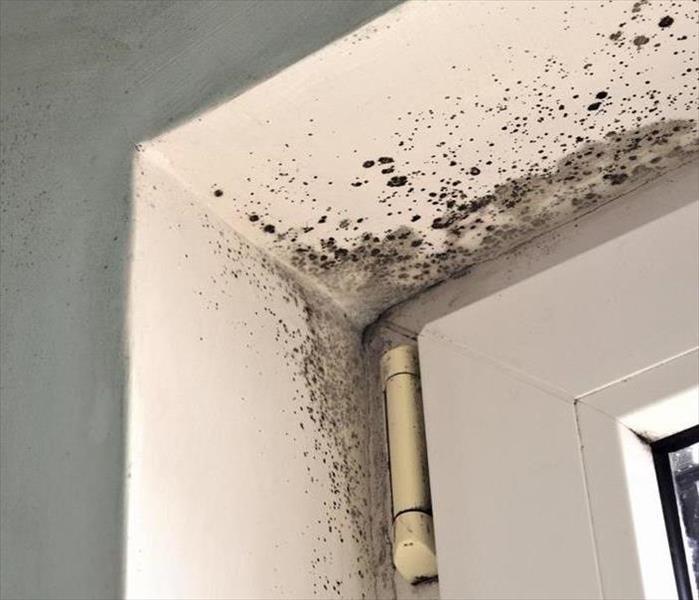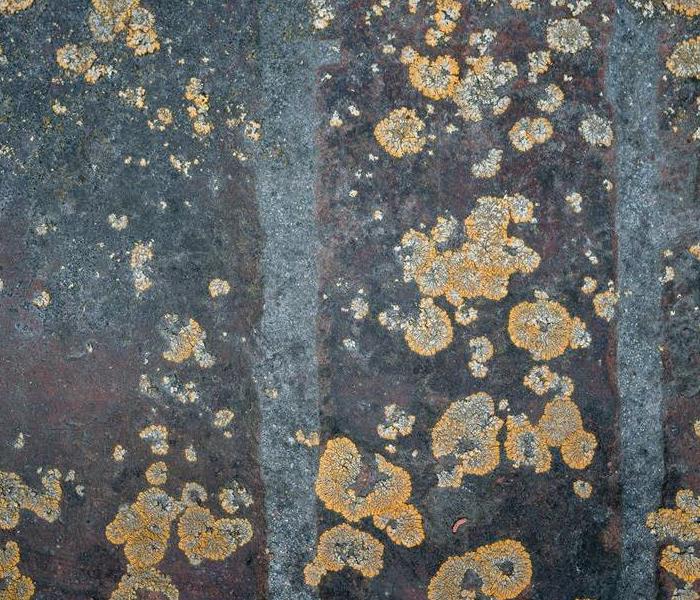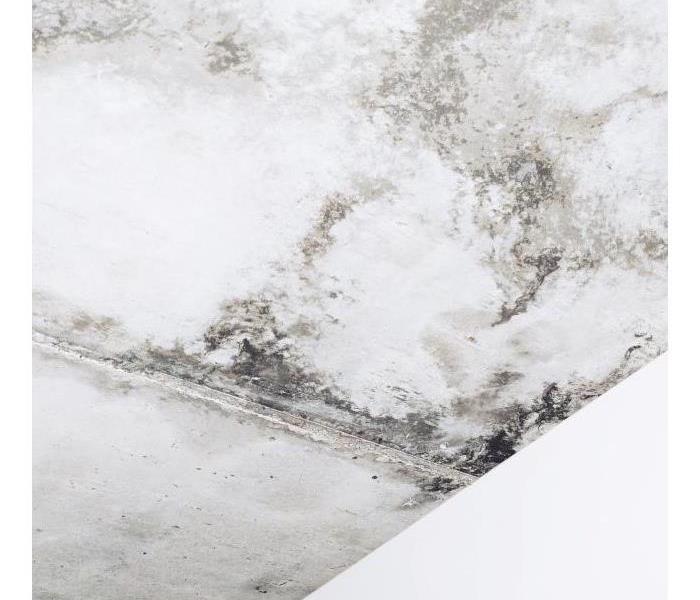Recent Mold Remediation Posts
Comprehensive Mold Remediation for Homeowners: SERVPRO of Fountain Valley
9/16/2024 (Permalink)
 Mold growth around a window due to excess moisture, requiring immediate remediation services.
Mold growth around a window due to excess moisture, requiring immediate remediation services.
Mold can appear in various areas of the home, from the attic down to the basement, and is often triggered by moisture issues like roof leaks, pipe leaks, or condensation around windows. Once mold begins to grow, it can quickly spread and become a serious health hazard. At SERVPRO of Fountain Valley, we specialize in mold remediation, ensuring your home is safe and mold-free.
Mold growth often occurs in dark, damp areas, making it difficult to detect until it's too late. Common signs include musty odors, visible dark spots, and allergic reactions in residents. Mold is particularly common after water-related incidents, such as a roof leak, pipe bursts, or even poor ventilation around windows.
Our expert team at SERVPRO of Fountain Valley uses advanced techniques to identify and remove mold from affected areas. We start by addressing the source of moisture to prevent future growth. Our mold cleaning services ensure that every contaminated surface is thoroughly treated, protecting your family’s health and restoring your home to a clean, safe environment.
If you suspect mold in your home due to water damage or leaks, don't wait. Contact SERVPRO of Fountain Valley today for fast and effective mold remediation services.
Here’s how you can prevent mold growth in your property
11/9/2020 (Permalink)
 Stop mold growth before it gets worse!
Stop mold growth before it gets worse!
Mold overgrowth can cause a lot of problems to your property. It’s also expensive to clean and repair after it has been severely damaged by mold. Of course, it’s better to prevent such problems from occurring. Here are the best ways to prevent mold infestations.
Inspect common areas that have mold growth
Molds grow and thrive in humid and damp conditions. The common areas of mold growth in a property are the bathroom, kitchen, and basement. You should check these areas if it has mold growth. Don’t forget to inspect areas that aren’t easily visible such as below the sink, under the toilet, etc.
Dry wet areas as soon as you can
After you finish using the bathroom, make sure to give it enough air flow by opening the door and windows. This will make it easier for the area to dry and prevent it from becoming a hotspot for molds. Same goes for other areas that are constantly exposed to water.
How to Prevent Molds in Your Home
5/21/2020 (Permalink)
 In Fountain Valley, mold can spread through a home in as little as 48 hours
In Fountain Valley, mold can spread through a home in as little as 48 hours
Molds can grow on areas that aren’t directly visible such as walls around leaking pipes, drywall, or other damp sections in your property. A mold problem doesn’t only impact your house but your health as well. Here are great tips on how to prevent molds from growing in your home.
Ensure Proper Ventilation
Effectively ventilating your home is an effective method to prevent molds. You can run an exhaust fan, and use AC units and dehumidifiers to keep your rooms ventilated. It’s important to clean these devices consistently to keep them ventilating effectively.
Dry Wet Surfaces As Soon As Possible
Don’t leave spills, water leaks, and other wet surfaces since these can cause mold growth. Also, don’t leave wet clothes in enclosed spaces since this can be a breeding ground for molds.
Identify areas that are prone to mold growth
There are areas in your home that are prone to mold because they’re exposed to moisture or water. It’s important to check these mold hotspots so you can mold-proof them. Most problem areas are the basement, pipelines, bathrooms, and other damp sections of your home.
If You See Signs of Mold, Call Us Today at (714) 361-0572
FASTER TO ANY SIZE DISASTER
SERVPRO of Fountain Valley is locally owned and operated, so we’re already close by and ready to respond immediately when you need us. We’re also part of a national network of over 1,700 Franchises, which gives us access to more resources for larger cleaning or restoration projects or major storm scenarios.
How Mold Cleanup is Done - A Step By Step
6/21/2017 (Permalink)
How Mold Cleanup is Done - A Step By Step
Mold damage in homes can become a problem in 24-48 hrs of water intrusion. The intrusion of water causes mold to form either gradual or intensive which requires remediation to take place. Leaks from roofing and water line if they go unnoticed may eventually lead to mold infestation. Mold damage can be severe when neglected for an extended period. After floods have occurred precautions, need to be undertaken before re-entering your home or business- to prevent commercial mold damage.
Molds and mildew are microscopic, and they happen everywhere, indoors, outdoors on vehicles so removing all of it is next to impossible. Mold in home has proven to be of great importance as it helps in the decomposition of organic matter. As a matter of fact, it placed on the food chain.
While outdoor mold and mildew are useful, the indoor are harmful to property and asset. So when affected by indoor molds, mildew or fungus mitigation process should be undertaken.But before taking up mold damage reductions, you should conduct several precautions for mold in homes can affect and harm your body.
Guidelines when dealing with commercial mold damage, mold removal and deodorization.
• Protect your eyes: Always wear goggles or safety glasses that cover your eyes completely to provide 100% protection from dust and small mold particles.
• Protect your skin: wear gloves before touching or handling moldy items.DO NOT touch items with mold using your bare hands.
• Protect your mouth and nose: wear a full-faced respirator or a half faced respirator when you plan to stay in the mold infested area for an extended period. Molds in homes and fungus have a smelly odor.
• Protect your loved ones from hazard: people who are asthmatic should stay away from moldy areas and away because they have a smelly odor, DON'T involve children in mold removal exercise. You should also watch out for wet floors they may cause accidents. After finishing up the mold removal process ensure that you shower and change your clothes to ensure that you don't carry them at home.
Understanding mold mitigation processes.
Mold damage occurs differently, and it requires a unique solution to manage it:which is mitigation. But in the general mold reduction process is the same and its procedures are the same. These are the steps for undertaking remediation for commercial mold damage:
• Inspection and assessment: this is mostly done with various technologies, mold, and fungus grow in areas clear from the view where it is damp. They feed on cellulose and water and prefers dark areas. Despite having a smelly odor, you require special machines to detect them.
• Mold containment: this containment procedure is done to reduce the spread of the molds. Procedures like negative air pressures that the fungus spores don't spread during the removal process. Negative air chambers isolate the contaminated area with a physical barrier. Fans are turned off to reduce the dissemination of this mold.
• Air filtration: you trap spores from the air, hence there is no spreading. Air scrubbers and vacuums are used to ensure no spread of the spores during the remediation process.
• Mold removal and removal of fungus infested materials: this step depends on the extent of the damage. Antifungal and antimicrobial treatment is undertaken to eliminate the fungi and the mildew colonies. Removal of mold infested materials such as walls, ceilings, and carpets is necessary to ensure they don't spread.
• Cleaning contents and assets: clean your walls, curtains, decorative items that may be affected by these molds. Here smelly odor is removed by using deodorants. A special team does the deodorization. Deodorization requires special equipment and the chemical used should be human-friendly.
• Restoration: depending on the extent of commercial mold damage or mold in the home repair should be undertaken. Restoration involves minor repairs, painting the wall and installing new carpet restoration may also include the rebuilding of some room in a home or business.
The above process should be undertaken by a professional as us of machines may require skilled personnel. However, if someone wants to conduct the mitigation,deodorization and remediation process by themselves you should follow the following steps:
• Put on protective gears
• Remove standing water. Ensure you remove all the waters within 24 hrs.
• Open all windows to let in fresh air while working on it.
• Use Dehumidifiers to remove moisture.
• Remove the molds you can see in your home.
• Fix the water problem completely and paint the whole area.
• Throw away the items that can't be cleaned or dry.
Visit http://www.SERVPROfountainvalley.com for more information on mold removal and remediation.
How To Undertake A Mold Removal And Remediation Project
6/1/2017 (Permalink)
How To Undertake A Mold Removal And Remediation Project
Molds depend on carbon atoms to survive. When the wood begins to rot, it releases the carbon by-products that the molds require to thrive. In the damp conditions, mold has adequate nourishment to develop in any part of your home. Surprisingly, mold can also develop in a clean home. If the home provides the necessary conditions for the mold to grow, the spores can germinate in a short time. The deodorization of the indoor air to get rid of the smelly odor is a futile endeavor. Mold removal entails creating a formidable remediation and mitigation plan. When planning your mold removal regimen, you must inspect the mold damage to develop a budget that considers the mitigation. The wet areas in a home include the basements, utility rooms, bathrooms, laundry areas, and kitchens.
How to Control Mildew and Fungus
Commercial mold damage can affect the walls and floors significantly. Remove all mold in home gutters and repair them to avoid spillages. While planning for mold removal and mitigation, you must assess the extent of mold damage. It is vital to inspect the drainage systems and floor traps where the black mold is likely to develop. Be sure to take the drastic steps to curb mold growth by keeping every surface clean and dry. Molds can grow on stones, wood, outdoor benches, and logs. Commercial mold damage can also affect your business negatively. Remediation and mitigation involve taking the right steps to eliminate the fungus and mildew. Eradicating the mold growth is almost impossible since the spores can spread to different locations in your home. You can use the following tips to prevent this menace in your home:
Improving the Ventilation
The remediation of mold damage entails removing the molds and eliminating the spores in the air. Poor ventilation in the basement leads to the accumulation of vapor and moisture. These damp conditions favor the growth of fungus, mildew, and molds that have a smelly odor. Improving the ventilation is a great way to dissipate the moisture in a natural way and avoid the cost or deodorization. Look out for mold in home footpaths and walkways. While deodorization can be a temporary solution to the smelly odor, adding another window will help to bring fresh air into the basement. You might also want to invest in a fan and a dehumidifier to circulate the air. Avoid exposing your home to the ravages of mold damage by improving the ventilation and keeping the spores out of bay.
Fix foundation cracks
Mold damage comes in many forms. Small cracks in the foundation can provide the habitat for mold growth since they allow some water to percolate into the foundation walls. Besides sealing the foundation cracks, you should inspect the gutters regularly. Remember to seal the window and door frames with the appropriate sealants to prevent the rainwater from seeping into the house. Ensure that you remove the mold in home HVAC and plumbing systems to curb the spread.
Avoid Stacking Items
Stacking items in your garden can also create the dark and wet conditions that favor the growth of mildew and fungus. Items such as firewood and broken furniture can create the perfect breeding ground for the molds. When these molds produce the spores, they can get into the bathrooms and kitchens. Avoid trapping moisture by organizing such items in a proper storage facility. The mold in home terraces and patios requires special attention during removal and deodorization.
HVAC systems
Commercial mold damage comes in many forms, but the HVAC systems can escalate the problem by distributing the spores in the entire building. When handling the commercial mold damage, start by cleaning the HVAC system. The heating and ventilation systems require regular checkup to keep them free of molds. Remember to clean the heating systems, air ducts, filters, and air conditioning systems regularly. This intervention will prevent the mold from spreading and growing in the entire home. The HVAC systems allow the spores and smelly odors to travel throughout a home quickly. Hiring a professional duct cleaner or HVAC technician for mold removal and remediation is better than investing in deodorization. Visit http://www.SERVPROfountainvalley.com/ for more information on mold removal and remediation.



 24/7 Emergency Service
24/7 Emergency Service


